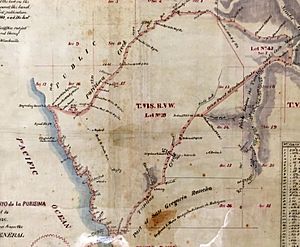Rancho Cañada de Verde y Arroyo de la Purisima facts for kids
Rancho Cañada de Verde y Arroyo de la Purísima was a large piece of land, about 8,906 acres (or 36 square kilometers), given out by the Mexican government. This happened in 1838 in what is now San Mateo County, California. Governor Juan B. Alvarado gave this land grant to José María Alviso. The name of the rancho means "ranch of the green valley and stream of the Purest," referring to the Immaculate Conception of the Virgin Mary. This land stretched along the Pacific coast, from Purisima Creek south to Tunitas Creek. It included areas known today as Lobitos and the old, abandoned town of Purissima.
History of the Rancho
The story of Rancho Cañada de Verde y Arroyo de la Purísima begins with a man named José María Alviso. He was a military officer from San Jose. José María asked the government for this large land grant, which was about two square leagues in size. He wanted it for his brother, José Antonio Alviso.
José Antonio Alviso was born in 1796 and lived until 1880. He was the oldest son of Josè Ygnacio Alviso and Margarita Bernal. In 1816, José Antonio Alviso married Maria Antonia de Jesus Pacheco.
Land Ownership Changes
After the Mexican-American War, California became part of the United States. This change was agreed upon in 1848 with the Treaty of Guadalupe Hidalgo. This treaty said that the United States would respect the land grants that Mexico had given out.
To make sure these land claims were official under U.S. law, a new rule was made. The Land Act of 1851 required people to prove they owned their land. So, in 1852, José Antonio Alviso filed a claim for Rancho Cañada de Verde y Arroyo de la Purísima with the Public Land Commission. This commission was set up to check all the old land grants.
The United States government tried to challenge Alviso's claim, but their appeal was turned down by the highest court in the country, the U.S. Supreme Court. Finally, in 1865, the land was officially granted to José Antonio Alviso with a special document called a patent. This meant his ownership was fully recognized by the U.S. government.


